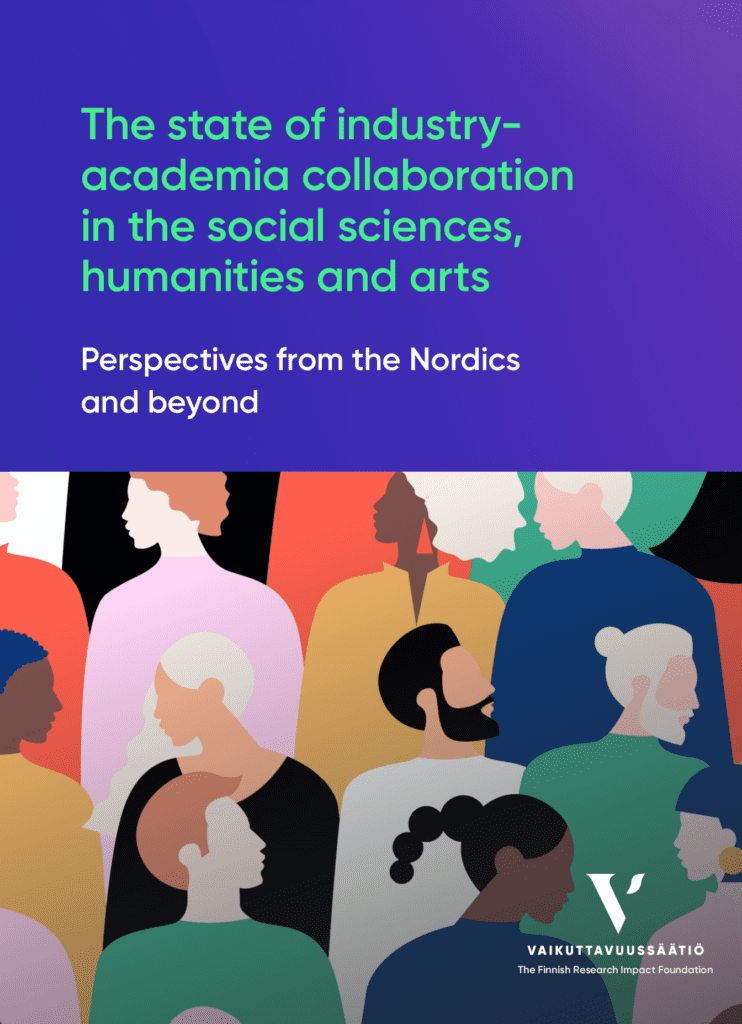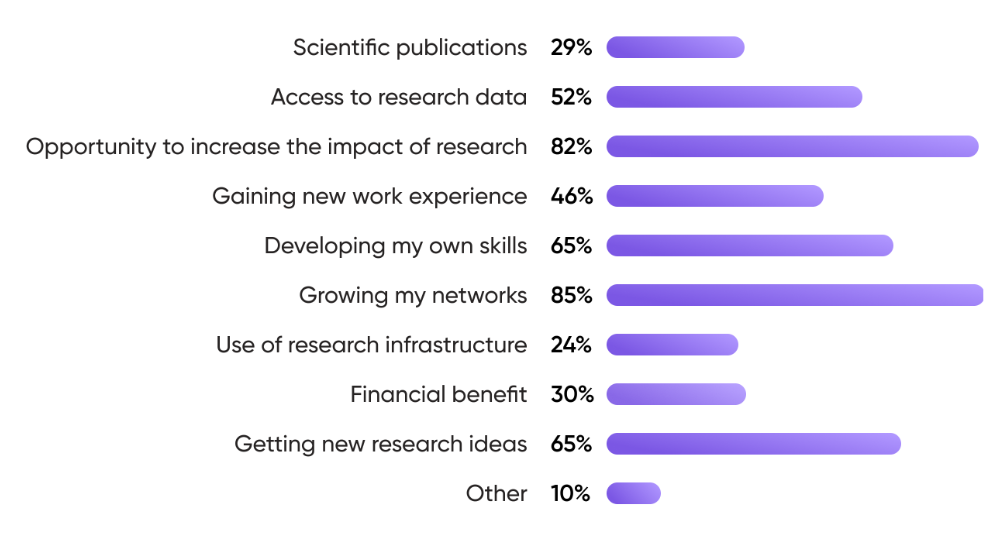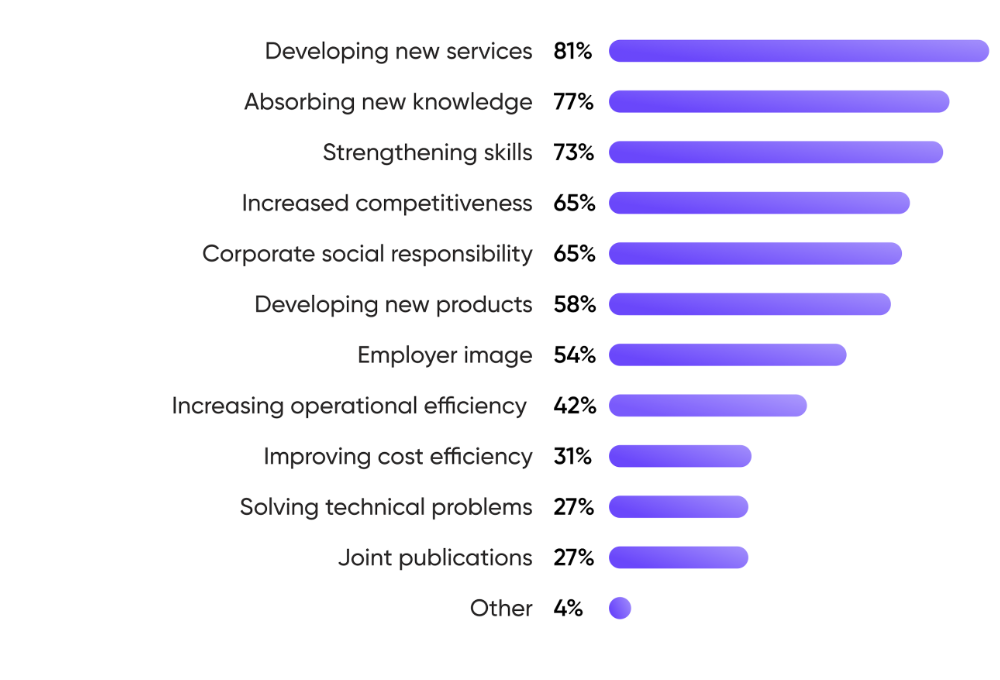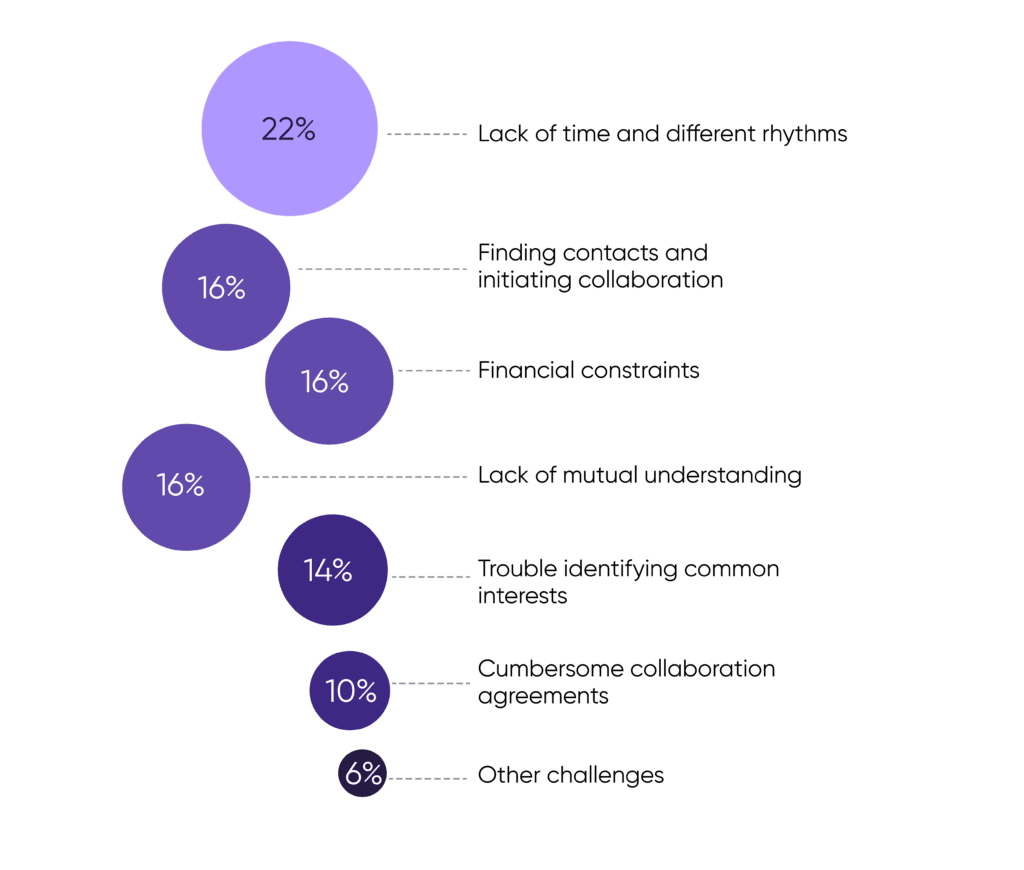The social sciences, humanities and arts have largely been absent from the landscape of industry-academia collaboration. Our 2023 whitepaper explores the relationship between these disciplines and industry collaboration and looks for ways of removing barriers to collaboration.
Whitepaper: State of industry-academia collaboration in humanities, arts and social sciences
Format: pdf
Size: 5,5 MB

In recent years public debate has increasingly highlighted the relevance of the social sciences, humanities and arts in understanding humanity, the functioning of society and addressing societal challenges. It is widely recognised that these disciplines can contribute to the positive development of society. However, it is still rare for these disciplines to actively collaborate with private enterprises in the same way that is typical for STEM (science, technology, engineering and mathematics) disciplines. Joint research projects are not common between companies and SHAPE researchers.
In 2023, we conducted an investigation into this topic that included a roundtable with representatives of Finnish academic institutions and other stakeholders, in-depth qualitative interviews with European experts and an online survey for Finnish academic and industry representatives.
The results of these inputs are now summarised in a whitepaper that we published on the 30th of November 2023. The purpose of this whitepaper is to contribute to the discussion on how impactful collaboration between SHAPE disciplines and industry could be furthered to benefit academic research, industry and society as a whole. Our aim is to encourage both academics and industry representatives to engage with this information and to use it to inspire and shape future collaboration.
Industry-academia collaboration is a key way of achieving impact for scientific research
Collaboration with private enterprises is a key way of achieving impact for scientific research. It can provide researchers with access to unique data, demonstrate the impact of research in practice and help in scaling research findings to benefit society more broadly. In return, collaboration can equip enterprises to better meet future challenges.
Traditionally, the STEM disciplines (science, technology, engineering and mathematics) have been more active in collaborating with the private sector when compared to the so-called SHAPE disciplines. Coined by the British Academy in 2020, SHAPE is an acronym for “Social Sciences, Humanities, and the Arts for People and the Economy”. It is an update to the previously used acronyms SSH and AHSS.
Traditionally, the STEM fields are more concerned with the straightforward commercialisation of science and thus with outcomes, such as the application of patents, the selling of licences and setting up spin-out companies than SHAPE fields. All these outcomes are measurable, making it easier to demonstrate the impact of STEM research.
In contrast, research in SHAPE disciplines is often more qualitative and abstract, making it harder to articulate the societal impact of this work. People working in the business sector may also struggle to see the practical applications of SHAPE research. This is reflected in the funding applications received by the Finnish Research Impact Foundation. Only 8% of all applications represent projects that involve SHAPE disciplines.
However, SHAPE research can provide industries with creative approaches, analytical tools and the human perspective they need to address complex social phenomena, such as the impact of AI on work and human interaction or social and environmental sustainability issues. By providing in-depth understanding of human behaviour, culture, creativity, history and society, SHAPE research can drive ethical and sustainable innovation as well as the development of innovative cultures in organisations.
A multitude of current trends in industry and society suggest that now is the time to investigate the value of the social sciences, humanities and arts to the private sector and our societies. These four current societal trends demand collaboration between SHAPE disciplines and enterprises:
- Societies are grappling with human problems that require multifaceted solutions.
- Artificial intelligence is shaping the way we work, interact and manage human relationships.
- The climate crisis is not being solved by STEM alone.
- Customer-centricity is the driving force behind successful businesses.
What is the current status quo of industry-academia collaboration within SHAPE disciplines?
We asked academics to describe what their collaboration with industry partners currently looks like. The results show that the collaboration can deliver several benefits for both parties involved.
Our survey results show that academics see industry collaboration as a great opportunity to widen their professional networks and increase the impact of their research. Having access to new contacts ties in with increasing research impact because speaking to new audiences brings the research out of the university and into the wider society.

(Respondents: academics, n=107)
Societal impact was a benefit that came across frequently in our in-depth interviews with experienced collaborators and experts. It was also mentioned by enterprises as an important outcome of these collaborations. It appears that societal impact is a key benefit that can equally motivate both parties to engage with one another.

What stands in the way of industry-academia collaboration in the SHAPE context?
Our data shows that both academics and enterprises can derive benefits from collaborating with one another. Yet, industry-academia collaboration is not widespread in the SHAPE context. We wanted to understand what is keeping researchers and enterprises from working together so that we could then imagine viable solutions. In our survey we asked academics and enterprises to give open-ended answers to this question and discovered several obstacles to collaboration that we then labelled under the following seven categories. Because we received significantly more replies from academics than enterprises, the categories presented here are more representative of the academic perspective.

How to move on and enhance collaboration between SHAPE disciplines and private enterprises
The future of research is grounded in collaboration. As public funders encourage universities and research institutions to show more leadership in creating societal and economic impact, all disciplines will be affected, including SHAPE. The question is not whether there should be more collaboration between SHAPE and private enterprises, but how that collaboration should be increased and who needs to be involved.
Our findings conclude that the task of enhancing collaboration cannot be accomplished by any one funder, higher education institution, academic or enterprise alone. The necessary changes may be structural, political and technical, but none of these changes can happen without dialogue and collaboration among all the parties involved.
Systemic approaches to collaboration need to be developed to increase collaboration
The challenge: SHAPE researchers and enterprises share a mutual interest in working with each other but struggle to make this happen. The birth of successful collaborations is dependent on individual awareness and interest, and on chance. A more systemic approach requires involvement on the part of universities, academics, funders and enterprises.
Potential solutions could include:
- Creating funding calls that are targeted at SHAPE disciplines and that encourage industry-academia collaboration.
- Supporting academics and enterprises to set up mutually beneficial projects.
- Setting up structures within universities to exhibit and introduce the work of social sciences, humanities and arts researchers to the private sector.
- Increasing diversity in corporate leadership to include people with backgrounds in the social sciences, humanities and arts or educating current staff about the benefits these disciplines can offer.
- Facilitating open-minded discussions about what it means to be an academic who collaborates with the private sector, exchanging experiences with other academics and defining the benefits of this type of collaboration from the academic’s perspective.
Industry-academia networks are key in facilitating collaboration
The challenge: SHAPE academics typically work in very small teams or alone and on small budgets. The lack of teamwork and large-scale projects limits the number of potential contacts for these academics and means they cannot create extended networks through other team members. Without appropriate networks, it is hard to imagine a collaborative project, contact potential collaborators or apply for funding.
Potential solutions could include:
- Building interdisciplinary teams that help to broaden networks and make new connections.
- Creating networking events where researchers and enterprises can meet.
- Encouraging brokerage from universities to establish relationships and connect the right academics with the right enterprises.
- Creating easy-to-access digital platforms or university consultancies that can help enterprises get in touch with the right researchers.
We need more versatile means to discuss and evaluate research impact
The challenge: In private enterprises, the language and discourse of impact are typically focused on economic outcomes and quantifiable results. Success is measured in terms of patents, products and revenue, which are typically not areas in which SHAPE disciplines can bring most value. Because of this, SHAPE disciplines are often excluded from traditional innovation and R&D spaces but rather employed in other areas of business, such as organisational development. This is not necessarily a problem, but it can limit the potential of academia-industry collaboration and reduce its impact.
Potential solutions could include:
- Increasing data and evidence on the impact of collaboration through carefully designed trials.
- Developing impact measures that reflect the unique nature of SHAPE research.
- Defining the added value that SHAPE disciplines can bring and communicating it effectively, also through quantifiable measures.
- Challenging the language of innovation and impact to embrace not just economic but also societal, environmental and other types of impact.
- Providing academics with the necessary skills to talk about their research from the perspective of impact.
- Demonstrating case studies of successful collaborations and their impact on both parties involved.
Are you interested in finding out more about the potential solutions that have already been tested or trialed across Europe to increase collaboration between SHAPE disciplines and private enterprises? Download our whitepaper and to learn more about:
- Findings from our survey on industry-academia collaboration among Finnish academics and industry representatives.
- Case studies from Finland, Sweden, Denmark, Ireland and the UK that describe the different approaches to increasing collaboration between SHAPE disciplines and enterprises.
- An executive summary that presents all our findings and proposed solutions to take action.
Would you like to learn more about the whitepaper, please contact the authors:
aurora.airaskorpi@vaikuttavuussaatio.fi
outi.vanharanta@vaikuttavuussaatio.fi
Author: Aurora Airaskorpi

